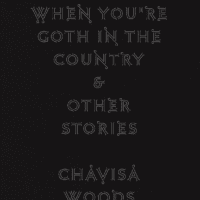When the swarms of black helicopters would pass over us in moments of bad consciousness I would remember the voice in the well saying, “Empathy. Child. All we Kill is ourselves.” I would look to the farmers saying, “Air force,” pointing their calloused fingers west and feel the wars which are endless and meant to be endless ripping open my guts with their flapping blades and I would know I was dead too. And I would know for a moment that it wasn’t only me painting my eyes so black and my skin so pale. It wasn’t something autonomous inside me making me need to look so dead.
From dive bars in rural Illinois to the parlors of St. Louis illuminati, the worlds of Chavisa Woods are full of demons. In the tradition of Shirley Jackson, William Faulkner, and Flannery O’Connor, Woods’s third full-length work, Things to Do When You’re Goth in the Country, explores the haunted terrain of the American psyche through grotesque depictions of characters and setting. These stories invoke an atmospheric malevolence that pushes characters to the brink of madness, violence, and transgression. But unlike Jackson’s haunted house or O’Connor’s secular characters, Woods’s subjects are not basically corrupt. Woods embraces the complex humanity of her characters even as she explores the tragedy of enculturation, identifying forces that divide us. Think of her as a literary exorcist, calling out certain entities that possess rural America: isolation, working-class poverty, drugs, incarceration, military dogma, and evangelical religion.
Woods’s characters encounter trauma at the intersection of gender, sexuality, and class. In the words of one protagonist who visits her hometown after moving to New York, “I moved away for a reason, I reminded myself. This place kills people, I reminded myself.” In a single night, this narrator faces potential threats from a family member with a gun, the authorities, and a fiercely grieved bartender. She desires not only to escape this threatening environment, but to take those she loves with her. Her caring forces her into an uneasy space between witness and participant as she reenters fraught terrain.
Sheldon, the narrator of “A New Mohawk,” is a young trans artist living in New York whose head sprouts a section of the dividing wall in Gaza, a living-scale model complete with tiny people who experience the events of that region as they actually happen, falling off his head when they die. While much of the story deals with the violence unfolding on Sheldon’s head, it’s the way the wall intersects with his pain as an unrequited lover and transgender person that lends the story depth. In a scene between Sheldon and his mother, she refuses to accept the new mohawk, equating it with his decision to undergo T-surgery. When Sheldon insists this is different because he didn’t have a choice about growing the Gazahawk, his mother coldly retorts that this is the same argument he used when he was preoperative: he had no choice about who he really was.
Woods allows ambivalence to complicate her stories so they cannot be reduced to rhetoric, though they remain staunchly political. The female narrator of “Take the Way Home That Leads Back to Sullivan Street” gets free rent in exchange for being the girlfriend of a “rich, straight girl.” The story shows how the deck is stacked: the wealthier character gains social capital by dating a woman, whereas the narrator loses what meager financial support she had from her parents for doing the same. But the narrator maintains agency—after all, she chose the relationship, and it facilitates her drug habit. The narrator’s girlfriend evolves into an antagonist, but she is humanized by her battle with mental illness and merciless pressure from her family to excel.
Especially for readers unfamiliar with her previous work in The Albino Album, which addresses racism head on, Woods’s foregrounding of issues related to class, gender, and sexual orientation might seem to come at the expense of their intersection with race. While dialect marks some characters’ speech, one cannot be sure if this is a mark of race, class, or regional background. It is possible that Woods obscures her characters’ race in order to draw attention to its status as a social construct, as writers such as Jeanette Winterson have done with gender. Even so, the text does address whiteness.
Alignment with the gothic literary tradition ties this collection to early American writers like Poe and Irving who helped forge a national persona that is anything but color-blind. As Toni Morrison has outlined in her work Playing in the Dark, gothic literature of nineteenth-century America afforded white writers a way of addressing their own disquiet about the formulation of American freedom, defined in part by contrast to people of color who were not free.
The fears Woods engages through the gothic genre reflect certain anxieties of contemporary white culture, which remain startlingly similar to those Morrison identifies in the literature of a much younger America:
Romance, an exploration of anxiety imported from the shadows of European culture, made possible the sometimes safe and other times risky embrace of quite specific, understandably human, fears: Americans’ fear of being outcast, of failing, of powerlessness; their fear of boundarylessness, of Nature unbridled and crouched for attack; their fear of the absence of so-called civilization, their fear of loneliness, of aggression both external and internal. In short, the terror of human freedom—the thing they coveted most of all.
It is 2017. America’s demons, which never died, have resurfaced yet again. We must ask ourselves: who stands in the shadows of our national persona, both historically and in the nation’s literature? Woods raises the question, and her work points toward an answer. Though aspects of her characters fit the dominant paradigm, none of them embodies that mythic object we call freedom.




